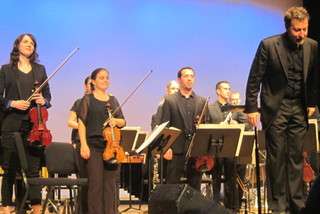|
Back
How Sweet to Sing of Clouds New York
Miller Theater,Columbia University
04/18/2013 -
Composer Portraits
Oliver Knussen: Ophelia Dances (Book I) – Secret Psalm – Hums and Songs of Winnie-the-Pooh – Songs Without Words – Requiem-Songs for Sue
Rachel Calloway (Mezzo-soprano), Jamie Jordan (Soprano)
Ensemble Signal: Kelli Kathman (Flute), Jessica Schmitz (Alto flute), Jacke LeClair (English horn), Eileen Mack, Adrian Sandi (Clarinets), Ken Thomson (Bass clarinet/clarinet), David Byrd Marrow (Horn), Kate Sheeran (Horn), Bill Solomon (Percussion), Oliver Hagen (Piano), Nuko Wadden (Harp), Courtney Orlando (Violin), Victor Lowrie, Christopher Otto (Violas), Kevin McFarland, Lauren Radnofsky (Cellos), Greg Chudzik (Double Bass), David Friend (Celeste), Oliver Hagen (Piano), Brad Lubman (Conductor)

O. Knussen (© Mark Allen/BBC/HarrisonParrott.com)
Never having seen a portrait of Oliver Knussen, I could only imagine him from his music: fastidious, elegant, lean, with a John Cage-ish visionary face and a wry twinkle.
The reality was much more endearing. In the concert last night, devoted to his chamber music, Oliver Knussen in person was more than simply as elegant as his beautifully constructed compositions. He is a large man, hirsute, a man who, yes, pretends to wear his heart on his sleeves (“I’m a very emotional person,” he told interlocutor/conductor Brad Lubman), but a person who has that rare gift of translating those emotions into musical jewels, not mawkish feelings.
Mr. Knussen’s many sides came out in the choices here. Alas, none of his glittering orchestral pieces, music which encompass the Medieval (in thought, sometimes in music), the mystical, the childlike, puppet theaters and fanfares.
But of these chamber work, two were of pure poetry, based on Hamlet’s Ophelia and poems by Walt Whitman. Three works were memorials, one to his late wife, two to colleagues. And one piece depicted the music for which is most justly famed, depicting the minds of children.
He is the ultimate conductor of David Del Tedici’s Alice, and his own operas based on the drawings of Maurice Sendak are highly praised. Yet in his notes, Paul Griffiths is spot on when he calls this “music for former children.”
For in his delightful song cycle, Hums and Songs of Winnie-the-Pooh, soprano Jamie Jordan could utter a four-second “Inscription”, go on to a total nonsense song (“Rumtum de diddle rumtum trala tiddle-um...”) with feverish glee, and literally “climb” way past high C in “Climbing, climbing, climbing and climbing, he climbed and climbed...”
The chamber orchestra wasn’t literally illustrating this (though bass clarinetist Ken Thompson played as low as possible for the “Hundred-Acre Wood”). And in the final poem, “Cloud Piece”, Ms. Jordan and the orchestra did what Mr. Knussen does best. She floated, the instruments floated, they wavered and wove, describing how “Ev’ry little cloud always sings aloud, ‘How sweet to be a cloud”...”
Mr. Knussen doesn’t wear his nostalgia on his sleeve either. Like his music, he is a very surprising person. Not when he mentions his adoration of Ravel and Stravinsky and Berlioz, but almost startling Brad Lubman when raving about the orchestration of Puccini. “Which,” he said, “is always underestimated.”
The surprises also came in two threnodies. For the death of a major violinist known for contemporary music, Mr. Knussen wrote a short work for solo violin which, amidst the soft whirling harmonics and string figurations, wove music from Bruch’s Violin Concerto, the essence of luscious, delicious schmaltz. Yet this was not irony. Knussen knew that the violinist loved that work, and he felt that it had to go into the memorial at his funeral.

B. Lubman/Signal (© Coco T. Dawg)
Most touching of all was the music which he wrote upon the death of his wife, Sue. Poems of Machado, Emily Dickinson, Auden and Rilke, all spun together without a break. Mr. Lubman and his Signal Ensemble (this the entire orchestra) gave the piece a freshness, never ever a morbidity, a gossamer-thin beauty of texture. And Rachel Calloway summoned up her mezzo charm to make each piece transparently beautiful.
The opening work, Ophelia Dances was the kind of music which Sir William Walton should have written for Sir Lawrence Olivier’s Hamlet, where Jean Simmons whirled away before her death. Mr. Knussen’s Dance was equally ethereal, the chamber orchestra lightly dancing with the solo flute playing tunes, not like Messian’s birds, but imaginary birds around Ophelia herself.
(His sequel, Ophelia’s Last Dance is a titanically difficult piano written for the young Kirill Gerstein, and well worth hearing.)
The other poetry was Walt Whitman. Not the words themselves (which Mr. Knussen previously set for soprano and orchestra). Here his lapidary skill gave color to the chamber orchestra, before, yes, another memorial, this to the great Polish composer Andrej Panufnik.
Mr. Knussen’s music is so rarely played in New York (the last time was Pinchas Zuckerman playing his Violin Concerto many years ago), but it is magical in many senses. Magical in resurrecting past times, in transcending the ordinary, magical in hiding music within music, that it must be played again and again here.
In a week filled with a series of American tragedies, how fortunate we were to hear a composer who can unveil the unending spiritual flowers within our fragile world.
Harry Rolnick
|